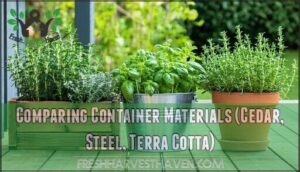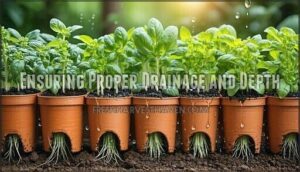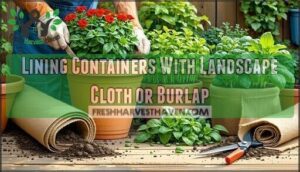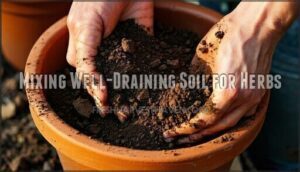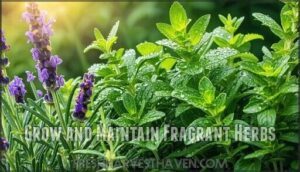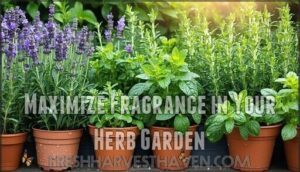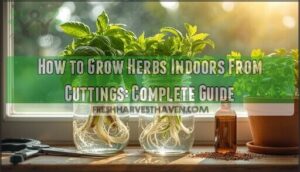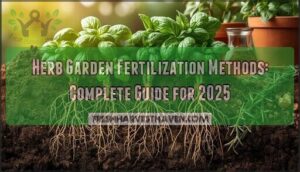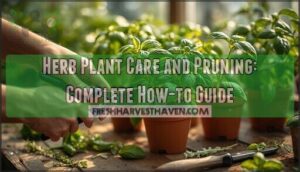This site is supported by our readers. We may earn a commission, at no cost to you, if you purchase through links.
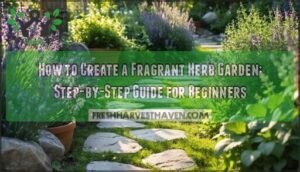
A subtle scent versus an overwhelming aroma hinges on thoughtful placement: where the morning sun shines, how the wind distributes the fragrance, even the path you choose to your front door. Herbs like rosemary and thyme, native to the Mediterranean, have evolved to emit their oils under specific conditions—intense sunlight boosts their fragrance compounds, and a little protection keeps the scent from disappearing before you can appreciate it.
A fragrant herb garden isn’t just about selecting the plants; it’s about appreciating how light, air movement, and ease of access combine to heighten what makes these plants so enchanting. Position your herbs carefully, and you’ll fashion sensory experiences throughout your day—from morning coffee near lemon verbena to evening strolls past night-blooming nicotiana.
Table Of Contents
Key Takeaways
- Your herb garden’s success depends on strategic placement—consider where morning sun hits, how wind carries fragrance, and which paths you walk daily to create natural moments of sensory enjoyment.
- Mediterranean herbs like rosemary and thyme need six to eight hours of full sun to release their aromatic oils, and smart use of windbreaks or reflective surfaces can amplify both their growth and scent.
- Container choice matters beyond looks—cedar resists rot, terra cotta breathes well, and all need 6-12 inches of depth with proper drainage holes plus a well-draining soil mix of compost and sand to prevent root rot.
- Give each herb enough space to prevent competing fragrances and crowding, which not only muddles the scent experience but also restricts airflow and increases disease risk.
Plan Around Garden Features
Before planting, really pay attention to what’s already there. Where you decide to place your herbs can completely change how they grow and smell.
Here are a few smart ways to arrange your garden so each plant can really shine.
Choosing The Best Location for Fragrance
What spot in your yard makes you want to stop, take a deep breath, and just enjoy the air? When creating a fragrant garden, keep these points in mind:
- Sunlight exposure for aromatic plants.
- Wind direction for scent movement.
- Foot traffic for daily enjoyment.
- How privacy and microclimates affect your garden.
Put the right plants in the right spots, and your fragrant herbs will flourish.
Maximizing Sunlight and Shelter
Once you’ve found the best spot for amazing fragrance, consider how much sun your herbs will get and if they’ll require some protection from strong winds or sudden storms. The majority of Mediterranean herbs thrive in full sun—aim for six hours each day. Try putting containers near surfaces that reflect light or act as windbreaks.
Here’s a short reference:
| Sunlight Duration | Shelter Materials | Microclimates |
|---|---|---|
| 6–8 hrs optimum | Burlap screens | Sides near brick walls |
| 3–5 hrs (partial) | Fences, trellises | Edges of garden paths |
| <3 hrs (shaded) | Potted evergreens | Under tree canopies |
Designing for Accessibility and Enjoyment
Now that you’ve set the stage with light and shelter, let’s make sure your fragrant herbs are always within easy reach—ready to snip, sniff, or simply enjoy as you stroll through your space.
- Keep wide pathways for Universal Access and Sensory Integration.
- Place child-friendly, therapeutic scented herbs along the edge.
- Cluster aromatic plants near benches for hands-on enjoyment.
Avoiding Competing Scents and Overcrowding
Keeping your favorite herbs within reach is a great idea, but give each plant enough room. Nothing ruins the experience like a garden where fragrances clash and leaves are too crowded.
Group plants with similar scents and growth habits together—this keeps everything organized and prevents one fragrance from overpowering another.
Just as important: leave enough space between them. Good airflow means healthier roots, less disease, and aromas that really shine.
| Tip | Why It Matters |
|---|---|
| Avoiding competing scents | Keeps each aroma distinct |
| Allow for airflow | Reduces disease, improves scent |
| Mind growth habits | Prevents crowding and poor vigor |
Select Containers and Prepare Soil
Now that you’ve chosen your location, consider what will house your herbs. The containers and soil you select will significantly impact your garden’s growth.
Here’s what you’ll need to gather before planting.
Comparing Container Materials (Cedar, Steel, Terra Cotta)
Choosing the best material for your herb garden’s containers is like finding the perfect pair of shoes—style is important, but comfort and sturdiness are what last all season.
Cedar provides great longevity and resists rot, but it can be pricier. Steel offers a modern aesthetic, but watch out for rust.
Classic terra cotta pots allow good airflow, but their relative lack of weight means they break easily.
Ensuring Proper Drainage and Depth
Even if your container garden is aesthetically pleasing, your herbs won’t flourish unless the roots have enough space and the water can drain properly. Choosing appropriate drainage prevents overly wet soil and root rot.
Container size should allow for adequate depth—6 to 12 inches is ideal. Drainage holes, a loose potting mix, and good drainage prevent soil compaction in container gardens.
Lining Containers With Landscape Cloth or Burlap
Before you fill your container with soil, consider landscape cloth or burlap as your secret weapon for keeping everything in place—roots included.
These liners help your fragrant herb garden flourish by:
- Preventing soil erosion and mess
- Allowing root penetration directly through the fabric
- Supporting well-drained soil for aromatic herbs
- Offering options—like burlap—for biodegradability and alternative liners, each with a unique fabric lifespan
Mixing Well-Draining Soil for Herbs
Great herbs start with great soil, so let’s discuss creating a mix where roots can breathe, not drown. For a standard blend, combine two parts compost (your preferred kind for balanced nutrients), one part sharp sand for drainage, and make sure the soil pH is close to neutral.
Drainage improvements and the right holes are key to a thriving herb garden.
Choose Plants Suited to Your Area
Choosing herbs that flourish in your region can completely transform your garden, making it both easier to care for and more fragrant. Since every climate has plants that do particularly well there, it’s worth finding out what actually succeeds in your specific area.
A few things to keep in mind:
Selecting Herbs for Your Climate Zone
Ever wondered why that basil wilts while thyme does so well? It’s all about Zone Adaptation and Microclimate Effects. Use the USDA hardiness zone map to match fragrant plants to your area:
- Note your zone’s winter lows,
- Check plant tags or guides,
- Select varieties bred for your region,
- Practice simple Overwintering Strategies and Adaptive Techniques—your herb garden will thank you.
Knowing your area’s hardiness zone rating is key for choosing herbs that will flourish.
Drought-Tolerant Vs. Moisture-Loving Herbs
Some herbs handle summer heat like sunbathers, but others will wilt unless you keep them watered—knowing the difference is key. Mediterranean herbs such as rosemary, lavender, and thyme thrive in well-drained soil with infrequent watering and lots of sun. However, basil and mint prefer moist soil, partial sun, and consistent watering.
Where you plant your herbs—and what you plant together—can turn a simple garden into something really special.
Sourcing Healthy Herb Plants or Seeds
Once you know which herbs thrive in dry conditions and which need plenty of water, the next thing is selecting robust plants or seeds to give your garden a head start. Focus on quality and variety:
- Get organic sources like Fedco Seeds or Strictly Medicinal Seeds
- Verify seed expiration dates
- Visit local nurseries for options that resist disease
- Find unique seed types
- Investigate propagation methods for gathering herb seeds
Seasonal Planting Tips (Spring Vs. Fall)
Once you have healthy seeds or starter plants, timing is key to how well your fragrant herbs take root. Spring herb starts thrive in warming soil and gentle rain, but planting in the fall encourages root growth as temperatures cool off before the first frost.
Check your local frost dates, prepare your soil well, and stagger your planting times for strong seasonal growth and hardy, aromatic plants.
Grow and Maintain Fragrant Herbs
Once you nail down the basics of herb care, keeping your garden healthy becomes straightforward.
Small adjustments—tweaking your watering routine or staying on top of pruning—can make all the difference.
As your herbs take off, here’s what deserves your attention.
Watering and Fertilizing Best Practices
Paying close attention to your herbs’ watering and feeding schedules sets them up to flourish, resulting in vigorous growth and an amazing scent. Regularly check the soil’s moisture and use soil that drains well. Change how often you water based on the season.
Use a weak, balanced fertilizer sparingly and watch for signs of lacking nutrients. These simple gardening hints make herb gardens truly satisfying.
Pruning for Shape, Size, and Scent Release
Once you’ve mastered watering and feeding, there’s real joy in shaping your herbs—not just for looks, but to coax out even more fragrance with every snip. Give these simple steps a shot:
- Pinch back the ends for bushier growth control.
- Prune regularly for scent intensification.
- Remove spent flowers.
- Shape to keep scented herbs compact and thriving.
Preventing and Managing Common Herb Problems
While tending a fragrant herb garden is a pleasure, you’ll avoid most problems with careful Garden Hygiene, attentive Plant care, and well-drained soil. Watch for Fungal Infections after rainy spells, address Soil Issues early, and use yellow sticky cards or biocontrol for Pest Control.
Many gardeners find that they can prevent issues by addressing herb garden issues proactively. Balanced watering and organic matter help minimize Nutrient Stress—simple gardening advice with a big payoff for herb garden upkeep.
Dividing and Replanting for Long-Term Health
Even the happiest herb garden can get crowded over time, so splitting up your plants now and then is the key to keeping them healthy and thriving for seasons to come. Divide mature clumps every few years for better rootbound prevention, soil enrichment, and extra herbs to share.
Try these quick tricks:
- Divide after a cool rain — the best time of year
- Use sharp tools for gentle plant division
- Mix in compost for ongoing herb garden upkeep
Maximize Fragrance in Your Herb Garden
Want your garden to smell as heavenly as it looks? Let’s talk about what really brings out those wonderful scents.
Here’s how to put fragrance front and center in your herb garden.
Top Fragrant Herb Varieties (Lavender, Lemon Verbena, Etc.)
Ever notice how a single brush of lavender or lemon verbena can lift your whole day? The magic in your fragrant herb garden starts with choosing remarkable herbs—each crafted for the best possible scent.
Explore the chart below for a sensory snapshot of varieties with top aromas:
| Herb Variety | Notable Scent Characteristic |
|---|---|
| Lavender Varieties | Soothing, floral, and long-lasting |
| Lemon Verbena | Bright, intense citrus aroma |
| Rosemary Scent | Piney, crisp, and eye-opening |
| Mint Profiles | Cool, menthol |
| Thyme Aromatics | Earthy, savory, slightly sweet |
Arranging Herbs for Optimal Scent Experience
Imagine walking into your garden and being greeted by a wave of fragrance—it’s like nature’s welcome. The arrangement is key. Begin by varying heights, placing taller aromatic herbs like rosemary in the back and shorter ones like thyme in the front.
Think about wind direction to help carry scents to you. Scent layering is most effective if you group fragrant herbs according to their bloom time. Strategic companion planting also improves your sensory garden’s overall effect.
Incorporating Night-Scented and Touch-Release Herbs
Some herbs save their best tricks for evening, but others require a nudge to wake them up—and that’s exactly why your fragrant garden benefits from both. Night-scented plants like lemon balm emit stronger aromas after sunset, ideal for evening herb care routines.
Touch-release oils in aromatic herbs such as lavender and thyme call for physical contact to release their fragrance. Aromatic groundcovers work beautifully in sensory garden design—plant them along pathways where you’ll naturally brush against them.
Using Garden Features to Enhance Aroma
The design of your garden isn’t just about plant placement; it’s about how you capture, elevate, and reroute scents so they linger instead of being carried away by the breeze. Thoughtful planning around garden focal points turns a simple scented garden into an immersive aromatic experience.
- Scented pathways lined with aromatic plant varieties emit oils as you brush past
- Aromatic walls and trellis structures fashion windbreaks that hold fragrance close
- Sensory seating tucked among your fragrant herb garden invites you to linger
- Water features boost scent molecules, carrying them through the air more effectively
Creative Uses for Your Fragrant Herbs
Your fragrant herb garden isn’t just pretty—it’s a living pantry for cooking, wellness, and crafting.
These herbs do more than smell incredible. They’re ready-to-use ingredients.
From quick weeknight meals to handmade gifts, there’s plenty you can do with them.
Here’s how to put your harvest to work in the kitchen, around the house, and beyond.
Fresh and Dried Herb Culinary Applications
Whether you’re snipping fresh basil for tonight’s pasta or grabbing dried oregano in January, herbs you’ve nurtured can turn everyday cooking into something special. Fresh herbs offer intense flavor—consider how cilantro brightens salsa or rosemary scents roasted potatoes.
Drying methods keep your harvest usable for months, though you’ll want to triple the amount when using dried instead of fresh.
Try pairing lemon verbena with fish, lavender in shortbread, or blending your own Herbes de Provence from homegrown thyme and marjoram.
Making Teas, Oils, and Butters
Beyond the kitchen, your fragrant herbs can become soothing teas, aromatic oils, and rich compound butters that capture the essence of your garden in completely new ways. Steep lemon balm or chamomile for calming herbal tea blends, or infuse olive oil with rosemary to fashion herb-infused oils for cooking.
Try these simple methods:
- Simmer fresh herbs in butter for aromatic herb butters
- Steep medicinal herb infusions like peppermint for digestive relief
- Combine culinary herbs in vinegars for dressings
Your fragrant herb garden becomes a year-round source of homemade wellness.
Crafting Potpourri and Herbal Sachets
Instead of tossing lavender petals, rose geranium leaves, and lemon verbena stems into your compost bin, consider them the ideal base for homemade potpourri and sachets. These will bring the garden’s fragrance inside throughout the year.
Make sure to fully dry your aromatic herbs, then combine plant types like hyssop and thyme for more layered potpourri recipes.
When selecting fabrics, use breathable cotton or linen for your sachet fillings to prevent moisture from getting trapped. Add fixatives such as orris root to help the scent last longer, and you’ve created thoughtful gifts straight from your fragrant herb garden.
Expanding Your Garden With New Aromatic Varieties
Once you’ve mastered the basics of potpourri and sachets, you’ll likely eye every catalog and nursery visit with a newfound curiosity about what other scented treasures you can tuck into your containers.
Try unusual aromatics like pineapple sage or chocolate mint to broaden your scent profiles beyond the usual suspects. Hybrid herbs and hard-to-find varieties let you explore new fragrant dimensions, and propagation methods like stem cuttings keep your aromatic plant collection growing without costing a fortune.
Frequently Asked Questions (FAQs)
How do I protect herbs from frost?
My container mint suffered 80% dieback when November temperatures unexpectedly plummeted—but neighbors who used frost covers saved theirs.
Shield tender herbs with covers or cloches if frost is in the forecast, and bring potted fragrant herbs indoors. Add a 2-3 inch layer of mulch around roots.
A cold frame beautifully extends the growing season.
Can herbs grow successfully in partial shade?
Yes, several shade-tolerant plants such as mint, parsley, and lemon balm do well in partial shade.
They still develop fragrant leaves even without much direct sunlight, though these plants usually have a stronger scent if they get more sun.
Keep this in mind as you care for them.
Which herbs attract beneficial insects or pollinators?
It’s funny how the most understated herbs often create the biggest buzz. Basil, lavender, thyme, and oregano are pollinator magnets, drawing in bees, butterflies, and other helpful insects.
This provides natural pest management and boosts biodiversity in your fragrant herb garden through smart companion planting.
How do I harvest herbs without killing them?
When gathering herbs, timing matters. Cut them in the morning after the dew has dried, and only take about a third of the plant at a time.
Use sharp, clean tools, and clip the stems just above the leaf nodes to encourage new growth.
After cutting, remember to water them well to help them recover.
What companion plants work well with fragrant herbs?
Marigolds attract helpful insects and keep aphids away, and nasturtiums serve as trap crops for pests.
Borage attracts pollinators and boosts soil health.
Chamomile encourages better growth and creates a more aromatic environment for the different herbs in your garden.
Conclusion
Envision your garden as a symphony—each herb adding its unique note that lingers. Cultivating a fragrant herb garden turns your outdoor area into a sensory escape, where brushing against rosemary or crushing mint releases nature’s own perfume.
You’ve already grasped the basics: thoughtful placement, suitable soil, varieties that thrive in your climate, and upkeep. Now, get gardening and watch those aromatic plants flourish, transforming ordinary moments into fragrant memories you’ll cherish all year.
- https://raleighrealty.com/blog/gardening-statistics-trends
- https://www.gardencentermag.com/news/gardening-trends-2025-economic-uncertainty-garden-media-group-spring-analysis/
- https://www.finegardening.com/article/improved-herbs
- https://cornellbotanicgardens.org/explore/gardens/fragrant-herbs
- https://bonnieplants.com/blogs/garden-fundamentals/how-much-do-i-plant

